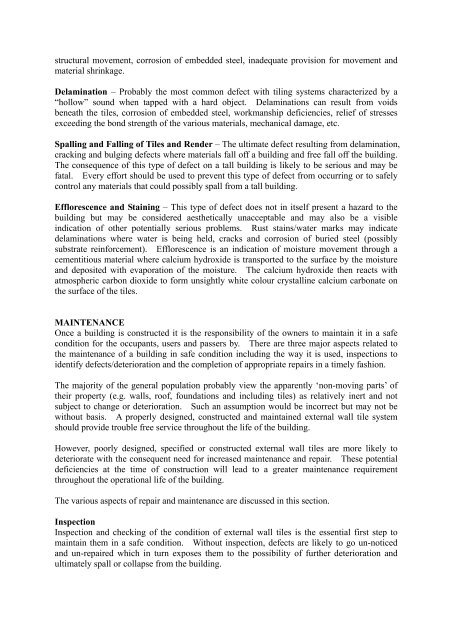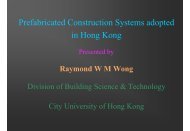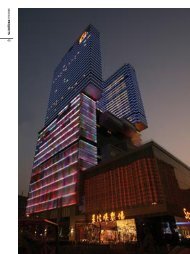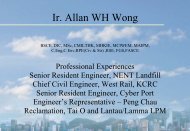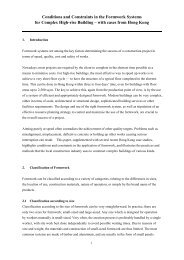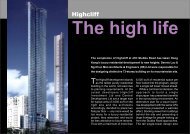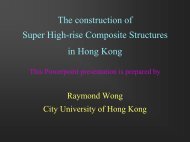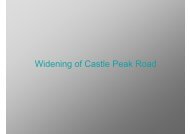installation and maintenance of external façade tiles on tall buildings
installation and maintenance of external façade tiles on tall buildings
installation and maintenance of external façade tiles on tall buildings
Create successful ePaper yourself
Turn your PDF publications into a flip-book with our unique Google optimized e-Paper software.
structural movement, corrosi<strong>on</strong> <str<strong>on</strong>g>of</str<strong>on</strong>g> embedded steel, inadequate provisi<strong>on</strong> for movement <str<strong>on</strong>g>and</str<strong>on</strong>g>material shrinkage.Delaminati<strong>on</strong> – Probably the most comm<strong>on</strong> defect with tiling systems characterized by a“hollow” sound when tapped with a hard object. Delaminati<strong>on</strong>s can result from voidsbeneath the <str<strong>on</strong>g>tiles</str<strong>on</strong>g>, corrosi<strong>on</strong> <str<strong>on</strong>g>of</str<strong>on</strong>g> embedded steel, workmanship deficiencies, relief <str<strong>on</strong>g>of</str<strong>on</strong>g> stressesexceeding the b<strong>on</strong>d strength <str<strong>on</strong>g>of</str<strong>on</strong>g> the various materials, mechanical damage, etc.Spalling <str<strong>on</strong>g>and</str<strong>on</strong>g> Falling <str<strong>on</strong>g>of</str<strong>on</strong>g> Tiles <str<strong>on</strong>g>and</str<strong>on</strong>g> Render – The ultimate defect resulting from delaminati<strong>on</strong>,cracking <str<strong>on</strong>g>and</str<strong>on</strong>g> bulging defects where materials fall <str<strong>on</strong>g>of</str<strong>on</strong>g>f a building <str<strong>on</strong>g>and</str<strong>on</strong>g> free fall <str<strong>on</strong>g>of</str<strong>on</strong>g>f the building.The c<strong>on</strong>sequence <str<strong>on</strong>g>of</str<strong>on</strong>g> this type <str<strong>on</strong>g>of</str<strong>on</strong>g> defect <strong>on</strong> a <strong>tall</strong> building is likely to be serious <str<strong>on</strong>g>and</str<strong>on</strong>g> may befatal. Every effort should be used to prevent this type <str<strong>on</strong>g>of</str<strong>on</strong>g> defect from occurring or to safelyc<strong>on</strong>trol any materials that could possibly spall from a <strong>tall</strong> building.Efflorescence <str<strong>on</strong>g>and</str<strong>on</strong>g> Staining – This type <str<strong>on</strong>g>of</str<strong>on</strong>g> defect does not in itself present a hazard to thebuilding but may be c<strong>on</strong>sidered aesthetically unacceptable <str<strong>on</strong>g>and</str<strong>on</strong>g> may also be a visibleindicati<strong>on</strong> <str<strong>on</strong>g>of</str<strong>on</strong>g> other potentially serious problems. Rust stains/water marks may indicatedelaminati<strong>on</strong>s where water is being held, cracks <str<strong>on</strong>g>and</str<strong>on</strong>g> corrosi<strong>on</strong> <str<strong>on</strong>g>of</str<strong>on</strong>g> buried steel (possiblysubstrate reinforcement). Efflorescence is an indicati<strong>on</strong> <str<strong>on</strong>g>of</str<strong>on</strong>g> moisture movement through acementitious material where calcium hydroxide is transported to the surface by the moisture<str<strong>on</strong>g>and</str<strong>on</strong>g> deposited with evaporati<strong>on</strong> <str<strong>on</strong>g>of</str<strong>on</strong>g> the moisture. The calcium hydroxide then reacts withatmospheric carb<strong>on</strong> dioxide to form unsightly white colour crys<strong>tall</strong>ine calcium carb<strong>on</strong>ate <strong>on</strong>the surface <str<strong>on</strong>g>of</str<strong>on</strong>g> the <str<strong>on</strong>g>tiles</str<strong>on</strong>g>.MAINTENANCEOnce a building is c<strong>on</strong>structed it is the resp<strong>on</strong>sibility <str<strong>on</strong>g>of</str<strong>on</strong>g> the owners to maintain it in a safec<strong>on</strong>diti<strong>on</strong> for the occupants, users <str<strong>on</strong>g>and</str<strong>on</strong>g> passers by. There are three major aspects related tothe <str<strong>on</strong>g>maintenance</str<strong>on</strong>g> <str<strong>on</strong>g>of</str<strong>on</strong>g> a building in safe c<strong>on</strong>diti<strong>on</strong> including the way it is used, inspecti<strong>on</strong>s toidentify defects/deteriorati<strong>on</strong> <str<strong>on</strong>g>and</str<strong>on</strong>g> the completi<strong>on</strong> <str<strong>on</strong>g>of</str<strong>on</strong>g> appropriate repairs in a timely fashi<strong>on</strong>.The majority <str<strong>on</strong>g>of</str<strong>on</strong>g> the general populati<strong>on</strong> probably view the apparently ‘n<strong>on</strong>-moving parts’ <str<strong>on</strong>g>of</str<strong>on</strong>g>their property (e.g. walls, ro<str<strong>on</strong>g>of</str<strong>on</strong>g>, foundati<strong>on</strong>s <str<strong>on</strong>g>and</str<strong>on</strong>g> including <str<strong>on</strong>g>tiles</str<strong>on</strong>g>) as relatively inert <str<strong>on</strong>g>and</str<strong>on</strong>g> notsubject to change or deteriorati<strong>on</strong>. Such an assumpti<strong>on</strong> would be incorrect but may not bewithout basis. A properly designed, c<strong>on</strong>structed <str<strong>on</strong>g>and</str<strong>on</strong>g> maintained <str<strong>on</strong>g>external</str<strong>on</strong>g> wall tile systemshould provide trouble free service throughout the life <str<strong>on</strong>g>of</str<strong>on</strong>g> the building.However, poorly designed, specified or c<strong>on</strong>structed <str<strong>on</strong>g>external</str<strong>on</strong>g> wall <str<strong>on</strong>g>tiles</str<strong>on</strong>g> are more likely todeteriorate with the c<strong>on</strong>sequent need for increased <str<strong>on</strong>g>maintenance</str<strong>on</strong>g> <str<strong>on</strong>g>and</str<strong>on</strong>g> repair. These potentialdeficiencies at the time <str<strong>on</strong>g>of</str<strong>on</strong>g> c<strong>on</strong>structi<strong>on</strong> will lead to a greater <str<strong>on</strong>g>maintenance</str<strong>on</strong>g> requirementthroughout the operati<strong>on</strong>al life <str<strong>on</strong>g>of</str<strong>on</strong>g> the building.The various aspects <str<strong>on</strong>g>of</str<strong>on</strong>g> repair <str<strong>on</strong>g>and</str<strong>on</strong>g> <str<strong>on</strong>g>maintenance</str<strong>on</strong>g> are discussed in this secti<strong>on</strong>.Inspecti<strong>on</strong>Inspecti<strong>on</strong> <str<strong>on</strong>g>and</str<strong>on</strong>g> checking <str<strong>on</strong>g>of</str<strong>on</strong>g> the c<strong>on</strong>diti<strong>on</strong> <str<strong>on</strong>g>of</str<strong>on</strong>g> <str<strong>on</strong>g>external</str<strong>on</strong>g> wall <str<strong>on</strong>g>tiles</str<strong>on</strong>g> is the essential first step tomaintain them in a safe c<strong>on</strong>diti<strong>on</strong>. Without inspecti<strong>on</strong>, defects are likely to go un-noticed<str<strong>on</strong>g>and</str<strong>on</strong>g> un-repaired which in turn exposes them to the possibility <str<strong>on</strong>g>of</str<strong>on</strong>g> further deteriorati<strong>on</strong> <str<strong>on</strong>g>and</str<strong>on</strong>g>ultimately spall or collapse from the building.


